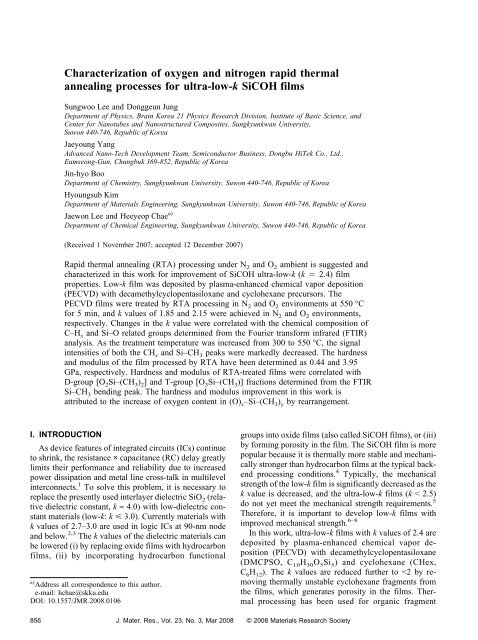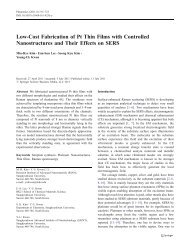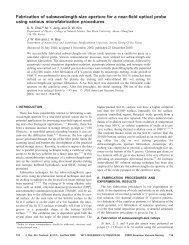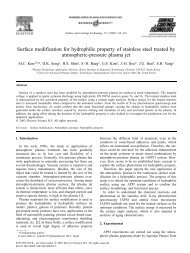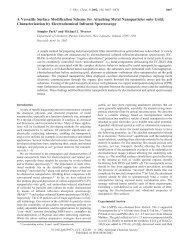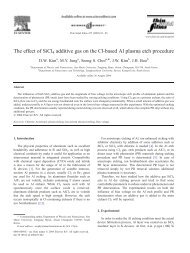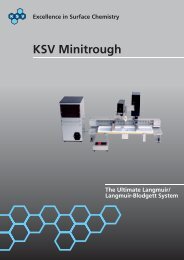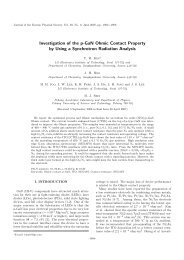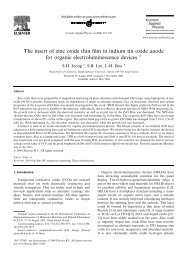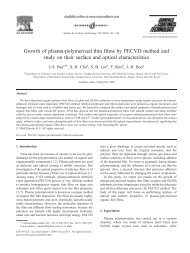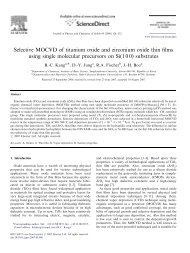Characterization of oxygen and nitrogen rapid thermal annealing ...
Characterization of oxygen and nitrogen rapid thermal annealing ...
Characterization of oxygen and nitrogen rapid thermal annealing ...
You also want an ePaper? Increase the reach of your titles
YUMPU automatically turns print PDFs into web optimized ePapers that Google loves.
S. Lee et al.: <strong>Characterization</strong> <strong>of</strong> <strong>oxygen</strong> <strong>and</strong> <strong>nitrogen</strong> <strong>rapid</strong> <strong>thermal</strong> <strong>annealing</strong> processes for ultra-low-k SiCOH filmsremoval. 3,5 In this work, we investigated <strong>rapid</strong> <strong>thermal</strong><strong>annealing</strong> (RTA) processing for formation <strong>of</strong> porosity byremoving hydrocarbon in the PECVD-deposited films.Furnace <strong>annealing</strong> typically requires long processing times,on the order <strong>of</strong> 1 h, while RTA systems require about aminute due to their fast temperature ramp-up rate. Therefore,productivity can be increased significantly with anRTA process. 9,10 Changes in molecular structure are correlatedwith hardness <strong>and</strong> modulus <strong>of</strong> films in this work.II. EXPERIMENTALThe SiCOH film was deposited using a PECVD system,which is described in detail elsewhere. 3,5 The basepressure <strong>of</strong> the deposition chamber was approximately10 −6 Torr. DMCPSO <strong>and</strong> CHex were vaporized in bubblersoperated at 75 <strong>and</strong> 45 °C, respectively, <strong>and</strong> thoseprecursors were introduced into the deposition chamberusing helium (99.99%) carrier gas. A radio-frequencypower <strong>of</strong> 13.56 MHz was delivered to the lower electrode.The films were deposited both on highly borondopedP + (
S. Lee et al.: <strong>Characterization</strong> <strong>of</strong> <strong>oxygen</strong> <strong>and</strong> <strong>nitrogen</strong> <strong>rapid</strong> <strong>thermal</strong> <strong>annealing</strong> processes for ultra-low-k SiCOH filmsFIG. 2. Elemental composition <strong>of</strong> as-deposited SiCOH film shown byAES depth pr<strong>of</strong>iling.decreased from 2.4 to as low as 1.85 as the treatmenttemperature was increased up to 550 °C. In the RTOprocess, the k value <strong>of</strong> 2.15 was obtained at the processingtemperature <strong>of</strong> 550 °C. The change in film thicknesswith RTA temperature variation is summarized inFig. 3(b). Little change <strong>of</strong> the film thickness was observedup to 300 °C. However, as the treatment temperaturewas increased to 350 <strong>and</strong> 400 °C both in the RTN<strong>and</strong> in the RTO processes, respectively, the films showedthickness reductions <strong>of</strong> 25% <strong>and</strong> 48%. Above 450 °C, nochange in thickness was observed. Similar thickness reductionwas reported by Grill <strong>and</strong> Neumayer in furnaceheat-treatment. 11Figure 4 shows the hardness <strong>and</strong> elastic modulus <strong>of</strong>the ultra-low-k SiCOH films as a function <strong>of</strong> treatmenttemperature. For RTO-treated films, the hardness <strong>and</strong>modulus were decreased with a treatment temperature<strong>of</strong> 400 °C. Above 450 °C, the hardness <strong>and</strong> moduluswere increased again. RTN-treated films show similarFIG. 3. RTA-treated SiCOH films: (a) k values <strong>and</strong> (b) thicknessretention (n), as a function <strong>of</strong> treatment temperature.FIG. 4. Mechanical strength <strong>of</strong> the SiCOH films: (a) hardness <strong>and</strong> (b)elastic (Young’s) modulus as functions <strong>of</strong> treatment temperature.858J. Mater. Res., Vol. 23, No. 3, Mar 2008
S. Lee et al.: <strong>Characterization</strong> <strong>of</strong> <strong>oxygen</strong> <strong>and</strong> <strong>nitrogen</strong> <strong>rapid</strong> <strong>thermal</strong> <strong>annealing</strong> processes for ultra-low-k SiCOH filmsto 450 °C, the reduction in the dielectric constant k isdue mainly to hydrocarbon removal in the film. We believethat the higher k values <strong>of</strong> RTO films than in RTNfilms were due to the large O–H peak contained in theFTIR spectra.We correlated the variation in the dielectric constant<strong>and</strong> mechanical strength with structural modificationsabove 400 °C in this work. Figure 7(a) shows the deconvolution<strong>of</strong> the Si–CH 3 bending b<strong>and</strong> <strong>of</strong> the as-depositedSiCOH films before RTN <strong>and</strong> RTO processing. Relative<strong>oxygen</strong> content in the O–Si–CH 3 structure is analyzed indetail; O–Si–(CH 3 ) 3 , O 2 Si–(CH 3 ) 2 , O 3 Si–(CH 3 ), <strong>and</strong>O 4 Si are defined here as M, D, T, <strong>and</strong> Q group, respectively,as in other reports. 15,16 Their peak positions are1250, 1260, 1270, <strong>and</strong> 1280 cm −1 , respectively. However,no M-group peak was observed for as-depositedSiCOH films. Figure 7(b) shows the relative area <strong>of</strong> theD- <strong>and</strong> T-group signal intensities divided by Si–CH 3peak intensity (in percent) as a function <strong>of</strong> the treatmenttemperature by RTN <strong>and</strong> RTO. The relative T-groupfraction in the Si–CH 3 peak (T group/Si–CH 3 ) was increasedfrom 36% to 50% in RTO-treated films <strong>and</strong> from35% to 44% in RTN-treated films as the treatment temperaturewas increased from 400 to 550 °C. As shown inFig. 7(b), the relative T-group fraction in the Si–CH 3peak in RTO-treated files was significantly higher than inRTN-treated films above 400 °C. However, the relativeD-group fraction in the Si–CH 3 peak (D group/Si–CH 3 )was decreased from 50% to 37% in RTO-treated films<strong>and</strong> from 53% to 42% in RTN-treated films as the treatmenttemperature was increased from 300 to 550 °C. Weattribute the increase <strong>of</strong> the T group to the cross-linking<strong>of</strong> the oxidized Si–O bonding induced by the radiationenergy in the RTA system. Figure 7(c) shows that hardness<strong>and</strong> relative area <strong>of</strong> the T groups/Si–CH 3 peak (%)in the FTIR spectrum as a function <strong>of</strong> RTN <strong>and</strong> RTOtreatment temperature. Notably, the hardness increasedfrom 0.1 to 0.44 GPa, <strong>and</strong> the T groups in the FTIRspectrum increased from 46% to 50% in RTO-treatedfilms. We believe that structural change from D to Tgroup can be attributed to the increase in hardness in theSiCOH films.FIG. 7. (a) Deconvolution <strong>of</strong> the Si–CH 3 bending b<strong>and</strong> <strong>of</strong> the asdepositedSiCOH film. (b) Relative area <strong>of</strong> D <strong>and</strong> T groups/Si–CH 3peak (%) in the FTIR spectrum as a function <strong>of</strong> RTN <strong>and</strong> RTO treatmenttemperature. (c) Hardness <strong>and</strong> relative area <strong>of</strong> the T groups/Si–CH 3 peak (%) in the FTIR spectrum as a function <strong>of</strong> RTN <strong>and</strong> RTOtreatment temperature.peak intensity <strong>of</strong> the SiCOH films saturated in the RTN<strong>and</strong> RTO films. The reduction <strong>of</strong> CH x <strong>and</strong> Si–CH 3 peakintensity is considered as an evidence for the removal <strong>of</strong>the <strong>thermal</strong>ly unstable hydrocarbon fragments. 3,12,14 UpIV. CONCLUSIONWe investigated ultra-low-k SiCOH films heat-treatedby RTA processing. A minimum dielectric constant (k)<strong>of</strong> 1.85 was achieved with the RTN process, <strong>and</strong> a k value<strong>of</strong> 1.98 was achieved with the RTO process after deposition.Hardness <strong>and</strong> modulus values <strong>of</strong> 0.44 <strong>and</strong> 3.95GPa were achieved with the RTO process. Improvementsin hardness <strong>and</strong> modulus are attributed to <strong>oxygen</strong> incorporationin the Si–CH 3 structure. In addition to improvementsin hardness <strong>and</strong> modulus, processing time <strong>and</strong><strong>thermal</strong> budget can be significantly reduced with RTA860J. Mater. Res., Vol. 23, No. 3, Mar 2008
S. Lee et al.: <strong>Characterization</strong> <strong>of</strong> <strong>oxygen</strong> <strong>and</strong> <strong>nitrogen</strong> <strong>rapid</strong> <strong>thermal</strong> <strong>annealing</strong> processes for ultra-low-k SiCOH filmsprocessing when it is compared with furnace <strong>thermal</strong>processes. Therefore, RTA-treated ultra-low-k SiCOHfilms have the potential to become a strong c<strong>and</strong>idate innew low-k interconnect development.ACKNOWLEDGMENTThis work was supported by the Science ResearchCenter (SRC) program (Center for Nanotubes <strong>and</strong> NanostructuredComposites) <strong>of</strong> Ministry <strong>of</strong> Science <strong>and</strong> Technology(MOST)/Korea Science <strong>and</strong> Engineering Foundation(KOSEF).REFERENCES1. M. Bohr: Interconnect scaling—the real limiter to high performanceULSI, in Technical Digest <strong>of</strong> the International ElectronDevice Meeting, Washington, DC (IEEE, Piscataway, NJ, 1995),pp. 241–244.2. A. Milella, J.L. Delattre, F. Palumbo, F. Fracassi, <strong>and</strong> R. d’Agostino:From low-k to ultralow-k thin-film deposition by organosiliconglow discharges. J. Electrochem. Soc. 153, F106 (2006).3. S. Lee, J. Yang, S. Yeo, J. Lee, J. Lee, D. Jung, J. Boo, H. Kim,<strong>and</strong> C. Chae: Effect <strong>of</strong> <strong>annealing</strong> temperature on dielectric constant<strong>and</strong> bonding structure <strong>of</strong> low-k SiCOH thin films depositedby plasma enhanced chemical vapor deposition. Jpn. J. Appl.Phys. 46(2), 536 (2007).4. J. Cui, J.M. Madsen, <strong>and</strong> C.G. Takoudis: A <strong>thermal</strong> processingsystem for microelectric materials. Meas. Sci. Technol. 15, 2099(2004).5. J. Yang, S. Lee, H. Park, D. Jung, <strong>and</strong> H. Chae: <strong>Characterization</strong><strong>of</strong> low-dielectric constant plasma polymer films deposited byplasma-enhanced chemical vapor deposition using decamethylcyclopentasiloxane<strong>and</strong> cyclohexane as the precursors. J. Vac. Sci.Technol., A 24, 165 (2006).6. L. Wang, M. Ganor, S.I. Roklin, <strong>and</strong> A. Grill: Nanoindentationanalysis <strong>of</strong> mechanical properties <strong>of</strong> low to ultralow-dielectricconstant SiCOH films. J. Mater. Res. 20(8), 2080 (2005).7. K. Kinoshita, A. Nakano, J. Kawahara, N. Kunimi, <strong>and</strong> Y. Hayashi:Vapor phase reactions in polymerization plasma for divinylsiloxanebis-benzocyclobutenefilm deposition. J. Vac. Sci. Technol. A. 24,2192 (2006).8. Y. Shioya, H. Shimoda, K. Maeda, T. Ohdaira, R. Suzuki, <strong>and</strong>Y. Seino: Low-k SiOCH film deposited by plasma-enhancedchemical vapor deposition using hexamethyldisiloxane <strong>and</strong> watervapor. Jpn. J. Appl. Phys. 44, 3879 (2005).9. C.Y. Chang <strong>and</strong> S.M. Sze: ULSI Technology (McGraw-Hill Companies,Inc., New York, 1996), p. 145.10. J.M. Shieh, S.C. Chang, B.T. Dai, <strong>and</strong> M.S. Feng: Investigation <strong>of</strong>superfilling <strong>and</strong> electrical characteristics in low-impurityincorporatedCu metallization. Jpn. J. Appl. Phys. 41, 5104(2002).11. A. Grill <strong>and</strong> D. Neumayer: Structure <strong>of</strong> low-dielectric constant toextreme low-dielectric constant SiCOH films: Fourier transforminfrared spectroscopy characterization. J. Appl. Phys. 94, 6697(2003).12. D.D. Burkey <strong>and</strong> K.K. Gleason: Temperature-resolved Fouriertransform infrared study <strong>of</strong> condensation reactions <strong>and</strong> porogendecomposition in hybrid organosilicon–porogen films. J. Vac. Sci.Technol., A 22, 61 (2004).13. J. Yang, C. Shim, <strong>and</strong> D. Jung: Effects <strong>of</strong> post-deposition in-situheat treatment on the properties <strong>of</strong> low-dielectric constant plasmapolymer films deposited using decahydronaphthalene <strong>and</strong> tetraethylorthosilicate as the precursors. J. Mater. Res. 17(6), 1248(2002).14. L.M. Han, J.S. Pan, S.M. Chen, N. Balasubramanian, J. Shi,L.S. Wong, <strong>and</strong> P.D. Foo: <strong>Characterization</strong> <strong>of</strong> carbon-doped SiO 2low k thin films: Preparation by plasma-enhanced chemical vapordeposition from tetramethylsilane. J. Electrochem. Soc. 148, F148(2001).15. Y. Lin, T.Y. Tsui, <strong>and</strong> J.J. Vlassak: Octamethylcyclotetrasiloxanebased,low-permittivity organosilicate coatings. J. Electrochem.Soc. 153, F144 (2006).16. A.D. Ross <strong>and</strong> K.K. Gleason: Effects <strong>of</strong> condensation reactions onthe structural, mechanical, <strong>and</strong> electrical properties <strong>of</strong> plasmadepositedorganosilicon thin films from octamethylcyclotetrasiloxane.J. Appl. Phys. 97, 113707 (2005).J. Mater. Res., Vol. 23, No. 3, Mar 2008 861


